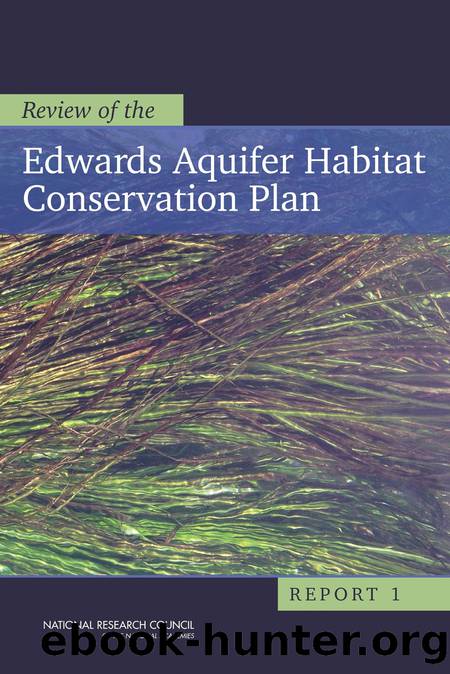Review of the Edwards Aquifer Habitat Conservation Plan: Report 1 by Committee to Review the Edwards Aquifer Habitat Conservation Plan

Author:Committee to Review the Edwards Aquifer Habitat Conservation Plan
Language: eng
Format: epub
Publisher: The National Academies Press
Published: 2015-06-16T00:00:00+00:00
TABLE 3-3 Long-Term Average and Minimum Total San Marcos Spring Discharge Management Objectives. These apply not only to Texas wild rice but also to fountain darter and other species.
Description Total San Marcos Discharge (cfs)a Time-step
Long-term average 140 Daily average
Minimum 45b Daily average
aAssumes a minimum of a 50-year modeling period that includes the drought of record
bNot to exceed six months in duration followed by 80 cfs (daily average) flows for 3 months.
SOURCE: EARIP, 2012, Table 4-13.
Habitat suitability criteria for water depth and velocity were used in the following equation to determine overall habitat suitability for Texas wild rice in various sections of the San Marcos River (Hardy, 2009):
Overall suitability = depth suitability à velocity suitability
where depth suitability and velocity suitability are determined by taking their respective values for the hydraulic simulation results at a node and using linear interpolation between the defined suitability values from the habitat suitability index curves. The suitability value determined for a computational cell is then multiplied by the cell area, generating a Weighted Usable Area for that cell. At a given simulated discharge, all Weighted Usable Area values are summed within a specific computational reach to generate a total quality-weighted area at the reach level.
Hardy (2009) provided results from multiple different habitat suitability analyses for Texas wild rice. Some of the later analyses benefitted from more precise physical modeling of the river system or from more recent data sets. Nonetheless, all of the analyses show the same basic trends, which are that the most suitable habitat for Texas wild rice seems to peak around 150 cfs, and that suitable habitat begins to decline below discharge rates of 100 cfs and drastically declines at rates below 65 cfs (Hardy, 2009, Figure 45). Observed Texas wild rice data superimposed on the model predictions for areas of suitable habitat provided some support for the modelâs ability to identify high and low quality habitat (see Figure 3-1). Many of the observed locations of Texas wild rice were in or near cells that were predicted to be high quality. Furthermore, the model predicted little to no Texas wild rice habitat in Spring Lake, which is expected because there is no flow in the lake above the threshold for Texas wild rice. Similarly, in the lower San Marcos River, the model predicted poor habitat because of deep water, which agrees with the lack of Texas wild rice in that area.
Several improvements were made in a subsequent habitat suitability analysis (Hardy et al., 2010). The two-dimensional hydrodynamic models and the QUAL2E models of the river systems were updated, and habitat criteria for Texas wild rice were updated based on more recent monitoring data (see Figure 3-2). Vegetation mapping was conducted in both river systems and integrated into the hydraulic modeling as spatially explicit roughness and in the habitat modeling as vegetation composition. The 2009 Texas wild rice monitoring data collected by the Texas Parks and Wildlife Department and FWS were combined with current vegetation maps.
The modeling approach was similar to previous analyses, in
Download
This site does not store any files on its server. We only index and link to content provided by other sites. Please contact the content providers to delete copyright contents if any and email us, we'll remove relevant links or contents immediately.
Whiskies Galore by Ian Buxton(41880)
Introduction to Aircraft Design (Cambridge Aerospace Series) by John P. Fielding(33064)
Rewire Your Anxious Brain by Catherine M. Pittman(18553)
Craft Beer for the Homebrewer by Michael Agnew(18140)
Cat's cradle by Kurt Vonnegut(15186)
Sapiens: A Brief History of Humankind by Yuval Noah Harari(14252)
Leonardo da Vinci by Walter Isaacson(13184)
The Tidewater Tales by John Barth(12608)
Thinking, Fast and Slow by Kahneman Daniel(12079)
Underground: A Human History of the Worlds Beneath Our Feet by Will Hunt(12024)
The Radium Girls by Kate Moore(11921)
The Art of Thinking Clearly by Rolf Dobelli(10223)
A Journey Through Charms and Defence Against the Dark Arts (Harry Potter: A Journey Throughâ¦) by Pottermore Publishing(9232)
Mindhunter: Inside the FBI's Elite Serial Crime Unit by John E. Douglas & Mark Olshaker(9201)
Tools of Titans by Timothy Ferriss(8218)
Wonder by R. J. Palacio(8010)
Turbulence by E. J. Noyes(7936)
Change Your Questions, Change Your Life by Marilee Adams(7635)
Nudge - Improving Decisions about Health, Wealth, and Happiness by Thaler Sunstein(7615)
